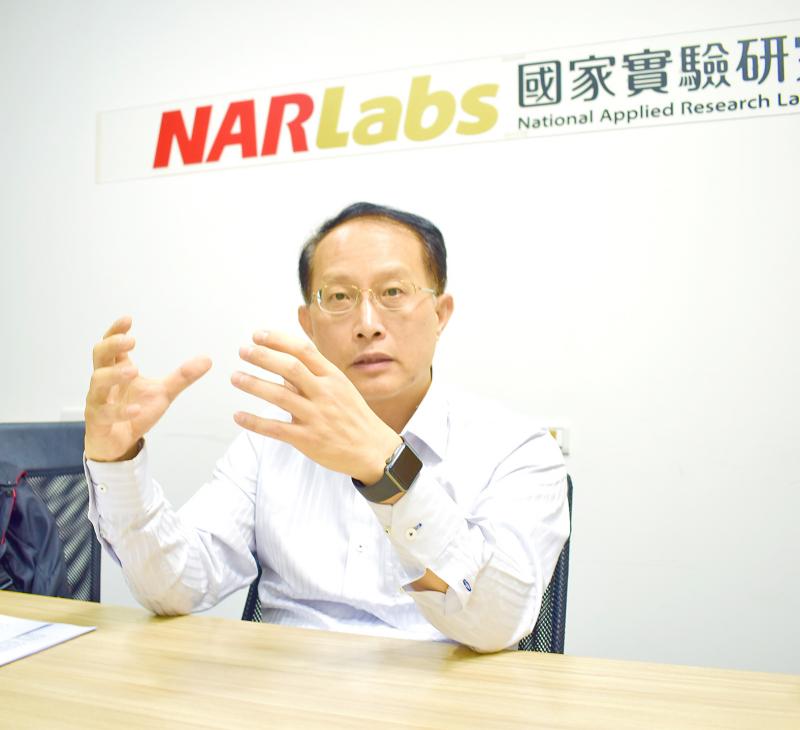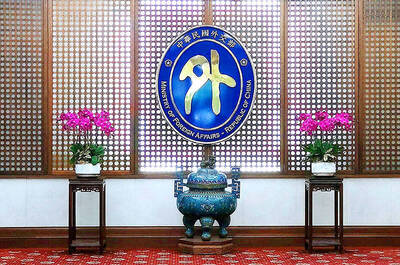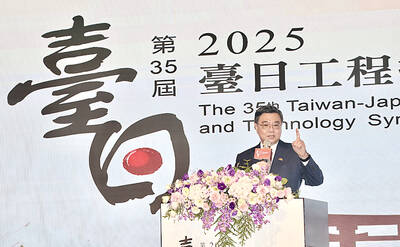With the National Space Organization (NSPO) — which is to mark its 30th anniversary in October — to be reorganized into a higher agency, questions have been raised as to how it would chart a new course in space development.
This year is crucial for the agency. Last month, it pushed the nation’s first space development bill through a legislative review. Once the regulations are in place, the organization is to be upgraded into an agency directly supervised by the Ministry of Science and Technology.
One of the NSPO’s priorities is to expand its cooperation with local businesses, said NSPO Acting Director-General Yu Shiann-jeng (余憲政), who has worked at the agency for 18 years and is a former deputy head of the National Center for High-performance Computing.

Photo: Lin Chia-nan, Taipei Times
For example, when developing the Formosat-8 constellation — a project that aims to launch six optical remote-sensing satellites with a resolution of 1m — the NSPO would use locally developed complementary metal-oxide-semiconductor image sensors, cameras, insulation materials and other components, Yu said in an interview on May 3.
Local suppliers can sell their components to overseas markets after their products prove that they are effective when deployed with the satellites, he said.
Local media have reported that US-based SpaceX had contacted the National Communications Commission to ask about communications service regulations, and earlier this year sent high-level executives to visit Taiwanese suppliers and government agencies.
SpaceX a few years ago started approaching Taiwanese companies that supply ground station components, Yu said.
Initially, local companies were suspicious of SpaceX’s ambitious plan to develop a worldwide broadband Internet system, called Starlink, comprising thousands of low-Earth-orbit satellites, as it had not yet launched 60 satellites at a time, he said.
In 2019, SpaceX sent representatives to visit the NSPO to seek collaboration opportunities and meet local companies, with discussions touching on ground station supplies and “other plans,” Yu said, without elaborating.
Local suppliers have since last year been receiving orders from SpaceX, although some have sought government help to weather the company’s rigorous payment conditions, he said.
While local suppliers have to face global competition, “almost all information and communications technology components, especially antennas, can be found in Taiwan, giving the nation a supply chain niche,” Yu said.
When the Executive Yuan in 2019 signed a phase 3 national space technology development program with a budget of NT$25.1 billion (US$900 million) over 10 years, the ministry placed more emphasis on the development of eight remote sensing satellites and two synthetic aperture radar satellites.
In January, the ministry announced a plan to develop the nation’s first low-Earth-orbit communications satellite, called Beyond 5G, which is scheduled to be launched by 2025.
Previously, satellites launched by Taiwan were mainly tasked with remote sensing or weather observations.
In the 1990s and in 2004, the NSPO attempted to develop a communications satellite, but the plans were suspended reportedly due to technical limits and other problems.
Some have questioned whether the NSPO would be able to develop such a satellite, given its lack of experience and facilities, but Yu said it has partnered with the Industrial Technology Research Institute (ITRI) for the Beyond 5G project.
The ITRI specializes in communications technology, but lacks experience developing products for use in space, which is the NSPO’s strength, he said.
Previous plans to develop a communications satellite targeted a geosynchronous orbit of about 36,000km, which required more sophisticated technology to develop a longer-lasting satellite, but building the Beyond 5G would be less challenging, Yu said.
The NSPO is also working with a European country to negotiate the use of frequency through the Ka and Ku portions of the electromagnetic spectrum, which are governed by the International Telecommunication Union, Yu said, without naming the country.
With rocket scientist Wu Jong-Shinn (吳宗信) on Aug. 1 to become director-general of the NSPO, questions have been raised over whether Taiwan could finally develop rockets to launch its satellites.
Sources familiar with the matter have said that the US has repeatedly expressed concern over Taiwan’s attempts to develop launch rockets.
A proposal seeking an Executive Yuan budget for that purpose during President Tsai Ing-wen’s (蔡英文) first term in office was shelved after US officials issued a warning, the sources said.
Diplomatic and cross-strait relations are factors to be considered when discussing rocket development, they said.
However, the “atmosphere” for rocket development has improved, as Taiwan-US relations have warmed, and Taiwan could obtain key components from non-US channels thanks to the increased commercialization of space technology, the sources said.
Asked about rocket development, Yu appeared more reserved, saying that the phase 3 space program does not include a plan to develop a launch rocket.
However, the program can be reviewed every two or three years if there is a policy change in higher government agencies, he said.
About one-third of a satellite project’s budget is to commission a rocket to launch the payload, meaning nearly NT$1 billion is spent on a launch, he said.
If Taiwan had its own launch rockets, it could save money and be more autonomous about its launch plans, which would complete the nation’s space technology development from the ground to space, he said.
However, the funds and technical problems involved in the development of launch rockets would not be small, and the current policy is not yet clear, he said.

The Ministry of Foreign Affairs (MOFA) yesterday voiced dissatisfaction with the Comprehensive and Progressive Agreement for Trans- Pacific Partnership (CPTPP), whose latest meeting, concluded earlier the same day, appeared not to address the country’s application. In a statement, MOFA said the CPTPP commission had "once again failed to fairly process Taiwan’s application," attributing the inaction to the bloc’s "succumbing to political pressure," without elaborating. Taiwan submitted its CPTPP application under the name "Separate Customs Territory of Taiwan, Penghu, Kinmen and Matsu" on Sept. 22, 2021 -- less than a week after China

ALIGNED THINKING: Taiwan and Japan have a mutual interest in trade, culture and engineering, and can work together for stability, Cho Jung-tai said Taiwan and Japan are two like-minded countries willing to work together to form a “safety barrier” in the Indo-Pacific region, Premier Cho Jung-tai (卓榮泰) yesterday said at the opening ceremony of the 35th Taiwan-Japan Modern Engineering and Technology Symposium in Taipei. Taiwan and Japan are close geographically and closer emotionally, he added. Citing the overflowing of a barrier lake in the Mataian River (馬太鞍溪) in September, Cho said the submersible water level sensors given by Japan during the disaster helped Taiwan monitor the lake’s water levels more accurately. Japan also provided a lot of vaccines early in the outbreak of the COVID-19 pandemic,

THE GOOD WORD: More than 100 colleges on both sides of the Pacific will work together to bring students to Taiwan so they can learn Mandarin where it is spoken A total of 102 universities from Taiwan and the US are collaborating in a push to promote Taiwan as the first-choice place to learn Mandarin, with seven Mandarin learning centers stood up in the US to train and support teachers, the Foundation for International Cooperation in Higher Education of Taiwan (FICHET) said. At the annual convention of the American Council on the Teaching of Foreign Languages held over the weekend in New Orleans, Louisiana, a Taiwan Pavilion was jointly run by 17 representative teams from the FICHET, the Overseas Community Affairs Council, the Steering Committee for the Test of Proficiency-Huayu, the

A home-style restaurant opened by a Taiwanese woman in Quezon City in Metro Manila has been featured in the first-ever Michelin Guide honoring exceptional restaurants in the Philippines. The restaurant, Fong Wei Wu (豐味屋), was one of 74 eateries to receive a “Michelin Selected” honor in the guide, while one restaurant received two Michelin stars, eight received one star and 25 were awarded a “Bib Gourmand.” The guide, which was limited to restaurants in Metro Manila and Cebu, was published on Oct. 30. In an interview, Feng Wei Wu’s owner and chef, Linda, said that as a restaurateur in her 60s, receiving an